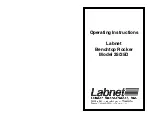
3. Make sure that the control panel of the Otosuite software is set to the correct transducer and desired routing and
sound level.
–
Make sure that uncomfortable loudness testing (UCL) is selected.
4. Start at a moderate level. Present the stimulus and then ask the patient if the current level is okay or uncomfortable.
Increase the presentation level in 5 to 10 dB steps until the patient's uncomfortable loudness level is determined.
5. Repeat steps
and
for each frequency if performing UCL testing for pure tones.
6. Switch to the other ear and tell the patient to listen for the sounds in that ear.
7. Repeat steps
and
for the opposite ear.
5.1.4
Assessing speech reception threshold (SRT) using the Hughson/Westlake procedure
1. Properly place the earphones.
–
Begin the test with the air conduction transducer.
2. Instruct the patient so that he/she will know what to expect: "You will hear various words, like hotdog, ice cream, ect.
When you hear a word, repeat it back to me even if the word is very soft. It is okay to guess if you are unsure of the
word."
3. Make sure that the control panel of the Otosuite software is set to the correct transducer and desired routing and
sound level.
–
Make sure that speech reception threshold (SRT) is selected.
4. Begin the test in the ear that has the lower PTA.
–
Inform the patient in which ear the test will begin.
5. Start presenting words at a level that should be clearly audible to the patient to confirm that the instructions for
responding were understood.
6. It is best to use recorded speech to reduce variability.
–
If the automated presentation speed of the recorded speech is too fast for the patient, you can deliver the recor-
ded words one at a time by double-clicking on the word in the word list.
–
You can also present the speech material using monitored live-voice.
7. If the patient responds to the initial sound level presented, proceed with the test by decreasing the level in 10 dB
steps until no response is obtained.
–
Increase the level in 5 dB steps until a response is obtained again.
–
Continue decreasing in 10-dB steps and increasing in 5-dB steps until you determine the lowest level at which the
patient responds correctly to two of three trials. This is the SRT.
–
Once the SRT is obtained, store the response.
8. If the SRT of the test ear and the SRT or PTA of the nontest ear differ by 45 dB or more, masking is needed.
If the SRT of the test ear and the bone conduction PTA of the nontest ear differ by 45 dB or more, masking is needed.
9. Switch to the other ear and tell the patient to listen for the words in that ear.
10. Repeat steps
to
.
11. The SRT will be ± 8 dB of the PTA for each ear if the data are reliable.
5.1.5
Assessing word recognition score
1. Properly place the earphones.
Madsen A450
65
5 Examples of audiometric testing
















































